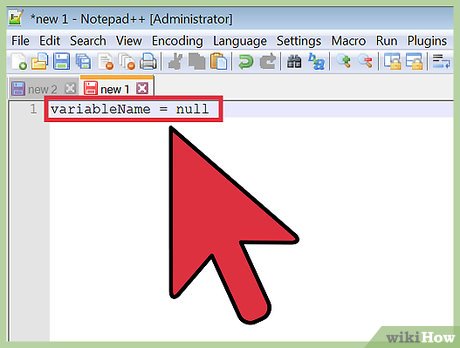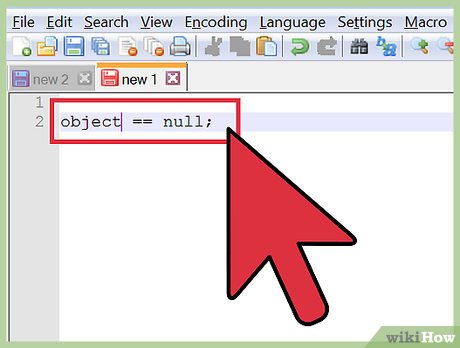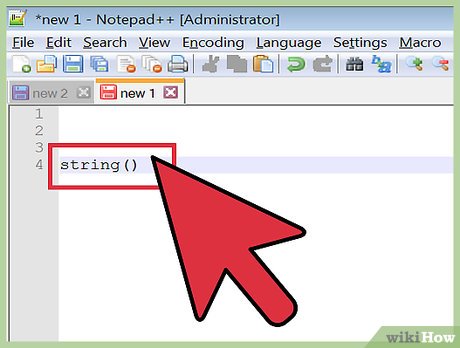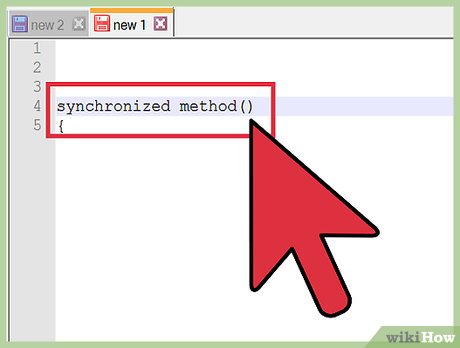How to Check Null in Java
Part 1 of 2:
Checking Null in Java
-
 Use '=' to define a variable. A single '=' is used to declare a variable and assign a value to it. You can use this to set a variable to null.
Use '=' to define a variable. A single '=' is used to declare a variable and assign a value to it. You can use this to set a variable to null.- A value of '0' and null are not the same and will behave differently.
variableName = null;
-
 Use '==' to check a variable's value. A '==' is used to check that the two values on either side are equal. If you set a variable to null with '=' then checking that the variable is equal to null would return true.
Use '==' to check a variable's value. A '==' is used to check that the two values on either side are equal. If you set a variable to null with '=' then checking that the variable is equal to null would return true.variableName == null;- You can also use '!=' to check that a value is NOT equal.
-
 Use an 'if' statement to create a condition for the null. The result of the expression will be a boolean (true or false) value. You can use the boolean value as a condition for what the statement does next.
Use an 'if' statement to create a condition for the null. The result of the expression will be a boolean (true or false) value. You can use the boolean value as a condition for what the statement does next.- For example, if the value is null, then print text 'object is null'. If '==' does not find the variable to be null, then it will skip the condition or can take a different path.
Object object = null ; if ( object == null ) { System.out.print ( "object is null "); } Part 2 of 2:
Using a Null Check
-
 Use null as an unknown value. It is common to use null as a default in lieu of any assigned value.
Use null as an unknown value. It is common to use null as a default in lieu of any assigned value.string()means the value is null until it is actually used.
-
 Use null as a condition for ending a process. Returning a null value can be used to trigger the end of a loop or break a process. This is more commonly used to throw an error or exception when something has gone wrong or an undesired condition has been hit.
Use null as a condition for ending a process. Returning a null value can be used to trigger the end of a loop or break a process. This is more commonly used to throw an error or exception when something has gone wrong or an undesired condition has been hit. -
 Use null to indicate an uninitiated state. Similarly, null can be used as flag to show that a process has not yet started or as a condition to mark to be beginning of a process.
Use null to indicate an uninitiated state. Similarly, null can be used as flag to show that a process has not yet started or as a condition to mark to be beginning of a process.- For example: do something while object is null or do nothing until an object is NOT null.
synchronized method() { while (method()==null); method().nowCanDoStuff(); } 3.8 ★ | 4 Vote
You should read it
May be interested
- What is Java? Why choose Java?
 what is java? java is a high-level programming language, developed by sun microsystem and released in 1995. java runs on a variety of platforms, such as windows, mac and various versions of unix.
what is java? java is a high-level programming language, developed by sun microsystem and released in 1995. java runs on a variety of platforms, such as windows, mac and various versions of unix. - Cursor NULL in C / C ++
 it is always a good practice to assign a null pointer to a pointer variable in case you don't know the exact address to be assigned. this is done at the time of variable declaration. a pointer that is assigned null is called a null pointer.
it is always a good practice to assign a null pointer to a pointer variable in case you don't know the exact address to be assigned. this is done at the time of variable declaration. a pointer that is assigned null is called a null pointer. - Basic Java syntax
 a java program can be defined as a collection of objects, communicating through calling each other's procedures. now we will look at the class, object, procedure and instance variable / instance variable to consider their meaning.
a java program can be defined as a collection of objects, communicating through calling each other's procedures. now we will look at the class, object, procedure and instance variable / instance variable to consider their meaning. - How to Run Java Files (.jar)
 today's wikihow will show you how to open and run executable jar files on a windows or mac computer. jar files (java archive - java archive) contain data that can be used with java programs. most jar files are simply a medium containing data that another program needs to run java; therefore, you cannot run these files and nothing happens when double-clicking them. similarly, most executable jar files are downloaded as installation files for the purpose of installing applications or programs. therefore, if you have problems opening the file, you should check whether your jar file is compatible with the operating system or not.
today's wikihow will show you how to open and run executable jar files on a windows or mac computer. jar files (java archive - java archive) contain data that can be used with java programs. most jar files are simply a medium containing data that another program needs to run java; therefore, you cannot run these files and nothing happens when double-clicking them. similarly, most executable jar files are downloaded as installation files for the purpose of installing applications or programs. therefore, if you have problems opening the file, you should check whether your jar file is compatible with the operating system or not. - What is JAVA file? How to open, edit and convert JAVA files
 a file with a .java extension is (or sometimes also used in .jav format) is a java source file written in the java programming language.
a file with a .java extension is (or sometimes also used in .jav format) is a java source file written in the java programming language. - eQuiz - Multiple choice quiz about JAVA
 following are multiple-choice questions related to java programming language, there will be 23 questions in total with no answer for each time. let's get started!
following are multiple-choice questions related to java programming language, there will be 23 questions in total with no answer for each time. let's get started! - Download and install Java on the computer
 to program java on your computer, you need to install the java environment, this tutorial will show you how to download and install java on your computer.
to program java on your computer, you need to install the java environment, this tutorial will show you how to download and install java on your computer. - Basic Java exercises, with sample decoding
 to serve your java learning needs, tipsmake.com has synthesized some java exercises from many sources, including sample code (for some articles). hopefully it can be helpful to learn your java programming language.
to serve your java learning needs, tipsmake.com has synthesized some java exercises from many sources, including sample code (for some articles). hopefully it can be helpful to learn your java programming language. - Which career Java programming options are waiting for you?
 java programmers are experts in the java programming language. as of 2018, there are many job opportunities for java programmers. with an expected growth rate of 19% for the period 2014-2024, the career prospects for the java language are really bright.
java programmers are experts in the java programming language. as of 2018, there are many job opportunities for java programmers. with an expected growth rate of 19% for the period 2014-2024, the career prospects for the java language are really bright. - How to install Java on a Raspberry Pi
 there are two different java implementations, oracle java and openjdk. this tutorial explains how to install java (openjdk) on a raspberry pi with the latest raspbian operating system running on it.
there are two different java implementations, oracle java and openjdk. this tutorial explains how to install java (openjdk) on a raspberry pi with the latest raspbian operating system running on it.












 How to Compile & Run Java Program Using Command Prompt
How to Compile & Run Java Program Using Command Prompt How to Check Your Java Version in the Windows Command Line
How to Check Your Java Version in the Windows Command Line ! = and! == What is the difference in JavaScript?
! = and! == What is the difference in JavaScript? The difference between the == and === operators in JavaScript
The difference between the == and === operators in JavaScript What is TypeScript? How to install TypeScript?
What is TypeScript? How to install TypeScript? Object Number in JavaScript
Object Number in JavaScript